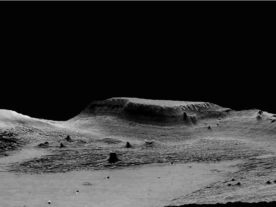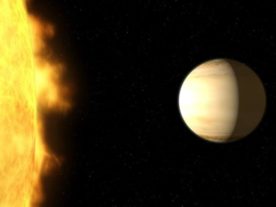
Iron and Titanium Found in Atmosphere of Ultra-hot Exoplanet
The chemical makeup of Earth’s atmosphere is said to contain about 78% Nitrogen and 21% oxygen, with argon, carbon dioxide, and other gases making up the remaining 1%. But an international team of scientists says they have detected vapors of iron and titanium in the atmosphere of what is considered to be the hottest “ultra-hot” […]

Volcanic Activity Created Martian Geological Oddity
Scientists have long been puzzled by a mysterious formation located near the equator of Mars called Medusae Fossae. A new study from a pair of scientists – Lujendra Ojha and Kevin Lewis – at the Johns Hopkins University in Baltimore suggests that the large deposit of soft rock was probably formed as a result of violent volcanic eruptions that […]

NASA Plans to Fly Helicopter on Mars
There are two robotic rovers traversing and exploring the surface of Mars – NASA’s Opportunity and Curiosity rovers. These rovers, along with two others (Sojourner & Spirit) from past missions, use(d) specially made wheels to get around the Red Planet. Instead of just wheels NASA now wants to try a different way to travel around Mars. […]

First Detection of Helium in an Exoplanet Atmosphere
Scientists say for the first several hundred thousand years or so after the Big Bang, there were virtually only two elements in the universe, hydrogen, and helium. A hydrogen atom is made of only one proton and one electron, and a helium atom has two each of protons, electrons, and neutrons. Hydrogen and then helium are […]

Life May Exist Among the Clouds of Venus
The search for extraterrestrial life has included examining the possibilities within and outside of the solar system. It has been thought that Mars and a couple of the moons of Saturn and Jupiter may hold the chance of having ET life. It’s also thought by some that a number of Earthlike extrasolar or exoplanets residing […]

Chinese Space Station Expected To Fall to Earth Within Days
Aerospace experts say they expect the Chinese space station, Tiangong-1, or “Celestial Palace 1” in English, to drop out of orbit and fall to Earth sometime between March 30th and April 2nd. Considering its orbital path and expected reentry trajectory, the experts say the space station could fall anywhere in the world between nearly 43° north […]

Lots of Water Detected in Exoplanet WASP 39b Atmosphere
Scientists, who studied a “hot Jupiter-like” exoplanet with NASA’s Hubble and Spitzer space telescopes, were able to detect signs of water in its atmosphere. And, they didn’t just find signs of a little water – but a lot of water, three times the amount of water on our solar system’s largest planet, Jupiter. The exoplanet they […]

Hubble Tracks Mysterious Storms on Neptune
When NASA’s Voyager 2 visited Neptune, in 1989, scientists noticed immense dark storms swirling in its atmosphere. Since then only the Hubble Space Telescope has had the ability to spot and track these mysterious storms. Hubble found a pair of these dark storms in the mid-1990s and then noticed they later had disappeared completely. The […]

Cosmic Rays Found to Impact Cloud Formation
A recent study from scientists at the Technical University of Denmark provides new evidence that cosmic rays play a role in cloud formation, thus affecting our climate. Cosmic rays are a form of fast-moving, high-energy radiation that emanates from the sun or from sources light years away from our solar system. According to the study, […]

New Insight Into TRAPPIST 1 Planets
Two new, but separate, studies provide fresh insight into planets orbiting the nearby red dwarf star TRAPPIST-1. One of the studies, published in the journal Nature Astronomy, suggests the atmospheres of at least three of the seven TRAPPIST-1 exoplanets found so far do not seem to be as hydrogen-rich as our solar system’s gas giant […]
